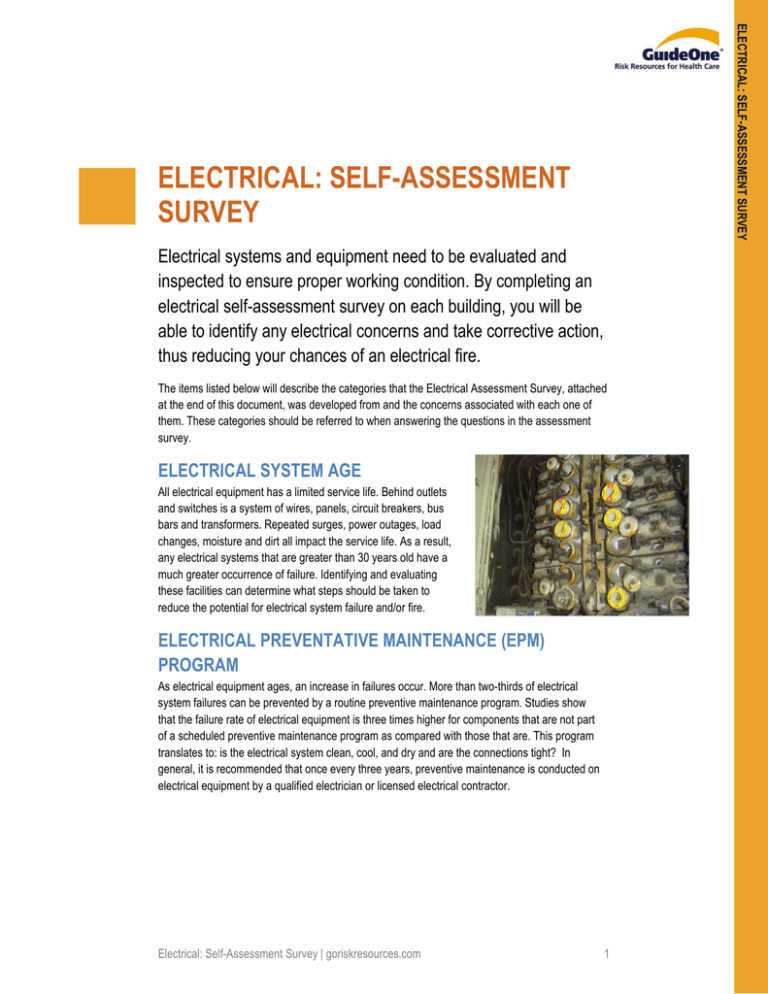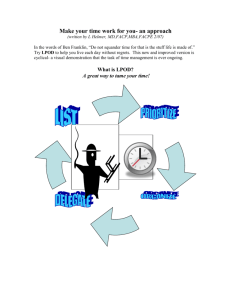
ELECTRICAL: SELF-ASSESSMENT SURVEY
ELECTRICAL: SELF-ASSESSMENT
SURVEY
Electrical systems and equipment need to be evaluated and
inspected to ensure proper working condition. By completing an
electrical self-assessment survey on each building, you will be
able to identify any electrical concerns and take corrective action,
thus reducing your chances of an electrical fire.
The items listed below will describe the categories that the Electrical Assessment Survey, attached
at the end of this document, was developed from and the concerns associated with each one of
them. These categories should be referred to when answering the questions in the assessment
survey.
ELECTRICAL SYSTEM AGE
All electrical equipment has a limited service life. Behind outlets
and switches is a system of wires, panels, circuit breakers, bus
bars and transformers. Repeated surges, power outages, load
changes, moisture and dirt all impact the service life. As a result,
any electrical systems that are greater than 30 years old have a
much greater occurrence of failure. Identifying and evaluating
these facilities can determine what steps should be taken to
reduce the potential for electrical system failure and/or fire.
ELECTRICAL PREVENTATIVE MAINTENANCE (EPM)
PROGRAM
As electrical equipment ages, an increase in failures occur. More than two-thirds of electrical
system failures can be prevented by a routine preventive maintenance program. Studies show
that the failure rate of electrical equipment is three times higher for components that are not part
of a scheduled preventive maintenance program as compared with those that are. This program
translates to: is the electrical system clean, cool, and dry and are the connections tight? In
general, it is recommended that once every three years, preventive maintenance is conducted on
electrical equipment by a qualified electrician or licensed electrical contractor.
Electrical: Self-Assessment Survey | goriskresources.com
1
RECURRING ELECTRICAL PROBLEMS
Recurring electrical problems, such as blown fuses, tripped breakers, flickering lights or overheated
appliance cords can be symptoms of overloaded circuits, improper grounding, non-code wiring,
loose connections and a host of other serious adverse conditions. These events also can indicate
potential problems with connected equipment, such as motors and transformers, as a result of
insulation breakdown, causing abnormal current draw. This increases the load on the system. A
qualified electrician should be tasked with identifying the cause and implementing the required
corrective action.
MISSING COVERS
Missing covers on junction boxes, panels, switches and receptacles expose energized circuits,
creating arc flash, shock, and electrocution hazards. In addition, missing covers provide a path of
entry into the interior of the enclosure, allowing dust, dirt, and debris to accumulate. Missing
knockouts or covers could allow metallic objects to fall into the circuits that could arc or lodge in a
way that presents a hazard when the enclosure is opened.
MAINTENANCE
Only a qualified electrician or licensed electrical contractor should be maintaining the electrical
system within your facility. It is important to determine if equipment is actually being inspected and
maintained and the skill level and qualifications of those performing the work. The risk of failures
and fires increase significantly when work is performed by unqualified personnel.
TEMPORARY WIRING
Temporary wiring is not compliant with the National Electrical Code (NEC) and increases the risk of
electrical equipment failure and fire. Wiring extension cords or electrical conductors that are not
properly routed through conduit directly into electrical panels are in violation of local and national
electrical codes. In addition, temporary wiring may not be properly sized for the voltage and
current. Improperly installed electrical equipment or spliced wiring also should be identified as
temporary and immediately removed from service by a qualified electrician or licensed electrical
contractor.
ELECTRICAL ROOM
Electrical equipment can and does fail, often catastrophically, with arcing that produces large
amounts of heat. Any combustible material in the vicinity of the arc flash can be ignited. Access to
electrical rooms should be limited to authorized maintenance or operations personnel that
understand the importance of maintaining a clean, well ventilated electrical area. Placing storage
items too close to electrical panels or near electrical equipment will restrict air circulation and
impede proper cooling. Excessive heat buildup will result in premature failure and shortened
service life. All ventilation vents and openings in equipment rooms should be kept clean and free
from obstructions. A concerted effort should be made to reduce the number of unused items and to
store items in a neat and orderly fashion. Storage must be no closer than 36 inches to the electrical
panels, electrical equipment, ventilation vents and openings.
2
goriskresources.com | Electrical: Self-Assessment Survey
Long-term exposure of metallic electrical components to moisture causes corrosion, and the build
up of corrosion by-products can lead to premature failure. Water entering electrical enclosures can
cause failures due to ground faults and arcing. Electrical equipment areas should be kept dry and
equipment should be protected from moisture. When evidence of moisture contamination is noted,
equipment should be examined for damage and necessary repairs made. The source of the
moisture needs to be identified and eliminated. All electrical work should be completed by a
qualified electrician or licensed electrical contractor.
The attached Electrical Self Assessment Survey should be completed for each building. This
assessment will produce a score of Low, Moderate or High based on the following:
• Low Exposure – 22-26 pts.: Electrical exposures were found to be acceptable. Exposure to
an electrical loss is low.
•
Moderate Exposure – 16-21 pts.: Electrical exposures were found to be acceptable,
however; further electrical risk assessments are recommended.
•
High Exposure – 0-15 pts.: Scores falling into this category have a high probability of
suffering an electrical loss, and a comprehensive visual inspection of the entire electrical
distribution system should be completed by a qualified licensed electrical contractor.
Electrical: Self-Assessment Survey | goriskresources.com
3
ELECTRICAL: SELF-ASSESSMENT SURVEY
PRESENCE OF MOISTURE
ELECTRICAL SELF-ASSESSMENT SURVEY
Electrical Assessment Question
*Score
Is any part of your electrical system greater than 30 years old?
(YES- 0 points, NO- 5 points)
Do you have an Electrical Preventive Maintenance (EPM) Program in
place that is conducted at least once every three years by a qualified
electrician or licensed electrical contractor?
(YES- 5 points, NO- 0 points)
Has your facility noted any recurring problems, such as blown fuses,
tripped breakers, flickering lights or overheated appliance cords?
(YES- 0 points, NO- 4 points)
Are there any missing covers on junction boxes, panels, switches or
receptacles?
(YES- 0 points, NO- 2 points)
Who is responsible for maintaining the electrical equipment and system?
(select one)
Electrical Contractor (3 points)
Maintenance Staff (2 points)
Other (0 points)
Do you have any temporary wiring within the facility?
(YES- 0 points, NO- 2 points)
Are combustible materials stored in the electrical room?
(YES- 0 points, NO- 2 points)
Have you noticed evidence of moisture or excessive dirt or dust on the
electrical equipment or panels?
(YES- 0 points, NO- 3 points)
TOTAL SCORE
* If a score of 0 is entered for any question, corrective actions should be taken.
Low Exposure: 22-26 pts.
Moderate Exposure: 16-21 pts.
High Exposure: 0-15 pts.
Name of person completing survey:____________________________________________
Date of survey: _________________
© 2012 GuideOne Risk
Resources for Health Care, a
division of Lutheran Trust, Asset
Management.
All rights reserved.
This material is for informational
purposes only. It is not intended
to give specific legal or risk
management advice, nor are any
suggested checklists or actions
plans intended to include or
address all possible risk
management exposures or
solutions.
You are encouraged
to consult with your own
attorney or other expert
consultants for a
professional opinion
specific to your situation.
GuideOne Risk Resources for
Health Care
1111 Ashworth Road
West Des Moines, Iowa 50265
1-800-688-3628
4
goriskresources.com | Electrical: Self-Assessment Survey

